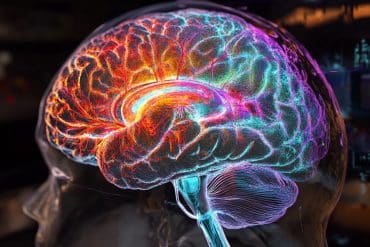Summary: Researchers report fear extinction memories form as a result of an adenosine modification, which help to increase the activity of specific genes.
Source: University of Queensland.
QBI researchers have discovered a DNA modification that enhances our ability to extinguish fear.
The findings, published in the journal Nature Neuroscience, could help guide the development of new treatments for fear-related anxiety disorders.
Professor Tim Bredy explains that while fear is an important survival mechanism in which cues in the environment tell us to respond in certain ways, so too is the ability to inhibit fear when it’s no longer needed.
“You still want to have that memory of ‘there’s something dangerous there, I want to be careful,’ but you don’t want it to compromise your ability to function normally,” he says.
Fear extinction works as a counter-balance to fear. It involves the creation of new non-fearful memories with similar environmental elements that compete with the original fear memory.
The balance between fear and fear-extinction is critical to cognitive flexibility, enabling the brain to rapidly adapt to changing conditions, says Prof Bredy.
Moreover, a key feature in both post-traumatic stress disorder (PTSD) and phobias is an impairment in fear extinction.
Key brain region plays critical role in fear extinction
Research has shown that a small region of the prefrontal cortex plays a critical role in fear extinction learning and memory processes, and the activity of neurons in this region is under tight epigenetic control.
“Your DNA is not static,” explains Prof Bredy. “Chemical tags on DNA act like a dimmer switch that can turn up or turn down the expression of a gene.”
Yet, precisely how fear extinction is regulated by such epigenetic changes has remained unclear.
For a long time, it was thought cytosine (C) was the only DNA base that could be modified. But it’s now clear that adenosine (A) can also be chemically tagged.
It was thought that such epigenetic modifications in the brain always serve to turn down a gene’s dimmer switch, reducing gene activity, explains QBI researcher Dr Xiang Li.
Moreover, only modifications to cytosine have been observed in association with learning and memory, he says.
Now, Prof Bredy, Dr Li and their colleagues have discovered that fear extinction memories form thanks to an adenosine modification that increases the activity of certain genes.
In the new study, mice were placed in a box where they heard a particular tone, which was immediately followed by a mild foot-shock. The mice quickly associated the sound with the foot-shock and froze when they heard it.
To encourage fear extinction, the mice were then placed in a different box, where they repeatedly heard the same sound, but did not receive any foot-shocks.
When the mice were returned to the original box, they were no longer afraid of the sound.
The researchers examined the DNA from the fear extinction neurons in those mice, and discovered the presence of a modified adenosine, N6-methyl-2-deoxyadenosine (m6dA), at more than 2800 locations across the genome.
In particular, the team discovered that m6dA accumulates at the gene for brain-derived neurotrophic factor (BDNF), which is known to nurture learning and memory.
Interestingly, m6dA increases expression of BDNF during fear extinction.
“It was thought that m6dA only plays a role in silencing genes,” says Prof Bredy, ‘but we’re saying, no, you have to look with a stronger magnifying glass.”
Look at these very specific neurons, he says, and look at what’s happening to their DNA when they’re actively learning.

Dr Li agrees. “This study is the first time people have investigated DNA modification not just in a cell-type specific way but state-dependent way,” he says.
“The most exciting part is that we found the accumulation of m6dA at BDNF only happened within active neurons.”
Epigenetic changes in extinction of fearful memories
In other words, this epigenetic change in the genomes of those neurons only occurs during fear extinction.
The enzyme responsible for chemically tagging adenosine and turning it into m6dA is well known, and Li reasoned that it must be very busy during fear extinction.
To confirm this, he switched off the gene for this enzyme in a group of mice, then repeated the experiment. The mice learned to fear the sound of the tone, but they were unable to form fear extinction memories.
Ultimately, both Prof Bredy and Dr Li want to understand the full picture of how fear extinction memory is formed and stored in the brain.
This work is an important step toward that and toward finding effective treatments for a variety of psychiatric disorders, says Dr Li.
“Understanding the fundamental mechanism of how gene regulation associated with fear extinction could provide future targets for therapeutic intervention in fear-related anxiety disorders.”
Source: University of Queensland
Publisher: Organized by NeuroscienceNews.com.
Image Source: NeuroscienceNews.com image is in the public domain.
Video Source: Video credited to QldBrainInstitute.
Original Research: Abstract for “The DNA modification N6-methyl-2’-deoxyadenosine (m6dA) drives activity-induced gene expression and is required for fear extinction” by Xiang Li, Qiongyi Zhao, Wei Wei, Quan Lin, Christophe Magnan, Michael R. Emami, Luis E. Wearick-Silva, Thiago W. Viola, Paul R. Marshall, Jiayu Yin, Sachithrani U. Madugalle, Ziqi Wang, Sarah Nainar, Cathrine Broberg Vågbø, Laura J. Leighton, Esmi L. Zajaczkowski, Ke Ke, Rodrigo Grassi-Oliveira, Magnar Bjørås, Pierre F. Baldi, Robert C. Spitale & Timothy W. Bredy in Nature Neuroscience. Published February 18 2019.
doi:10.1038/s41593-019-0339-x
[cbtabs][cbtab title=”MLA”]University of Queensland”Extinguishing Fear Memories Relies On An Unusual Change to DNA.” NeuroscienceNews. NeuroscienceNews, 19 February 2019.
<https://neurosciencenews.com/fear-memory-genetics-10772/>.[/cbtab][cbtab title=”APA”]University of Queensland(2019, February 19). Extinguishing Fear Memories Relies On An Unusual Change to DNA. NeuroscienceNews. Retrieved February 19, 2019 from https://neurosciencenews.com/fear-memory-genetics-10772/[/cbtab][cbtab title=”Chicago”]University of Queensland”Extinguishing Fear Memories Relies On An Unusual Change to DNA.” https://neurosciencenews.com/fear-memory-genetics-10772/ (accessed February 19, 2019).[/cbtab][/cbtabs]
Abstract
The DNA modification N6-methyl-2’-deoxyadenosine (m6dA) drives activity-induced gene expression and is required for fear extinction
DNA modification is known to regulate experience-dependent gene expression. However, beyond cytosine methylation and its oxidated derivatives, very little is known about the functional importance of chemical modifications on other nucleobases in the brain. Here we report that in adult mice trained in fear extinction, the DNA modification N6-methyl-2’-deoxyadenosine (m6dA) accumulates along promoters and coding sequences in activated prefrontal cortical neurons. The deposition of m6dA is associated with increased genome-wide occupancy of the mammalian m6dA methyltransferase, N6amt1, and this correlates with extinction-induced gene expression. The accumulation of m6dA is associated with transcriptional activation at the brain-derived neurotrophic factor (Bdnf) P4 promoter, which is required for Bdnf exon IV messenger RNA expression and for the extinction of conditioned fear. These results expand the scope of DNA modifications in the adult brain and highlight changes in m6dA as an epigenetic mechanism associated with activity-induced gene expression and the formation of fear extinction memory.






